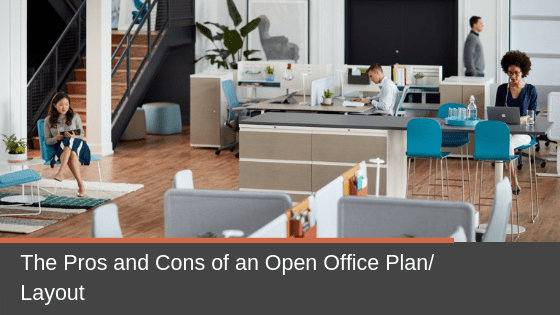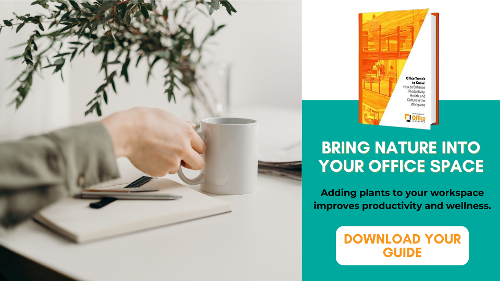It seems people love or hate open office plans. People who love them say they spark collaboration and boost productivity. Detractors say they snuff out creativity and distract employees from their work.
No matter which side of the debate you’re on, open office layouts are one of the most popular designs for modern offices. But is an open office right for you? Here are a few pros and cons to consider before you start tearing down walls or getting rid of your cubicles.
The Upside of an Open Office Plan
Unlike traditional office layouts that are carved up into numerous offices, meeting rooms and rows of cubicles, open office plans seem more inviting and invigorating.
While the open office has become the face of innovation in Silicon Valley with companies like Facebook and Google building offices that are huge collaboration hubs, is being cool a good reason for you to replace your existing office design with an open layout? Probably not, but there are a few sound reasons to consider it.
- Promotes collaboration – This is a contentious one. Not everyone is sold on this fact, and some studies have shown the opposite to be true. In theory, open spaces should enhance collaboration because people are no longer tucked away in small areas doing their own thing.Wide open spaces increase the likelihood of chance meetings and make it easier for employees at all levels to work together. Without physical barriers separating them employees are more likely to communicate, so even managers can feel more approachable.
- Lowers costs – Open offices are more cost-effective than traditional layouts with cubicles or private offices because you don’t have to spend money on cubical walls and large desks.You can also fit more workstations into an open space, reducing the amount of square footage you need. One recent study showed that thanks to open office plans, average square footage per worker dropped by 33 percent between 2010 and 2017.
- Encourages activity – Research shows open office layouts help employees get more physical activity while at work, which leads to lower levels of stress outside the office.In one study of government workers in the US, people who worked in open offices were 20 percent more physically active than workers in cubicles. They also reported being less stressed outside the workplace
- Offers flexibility – Workspaces without walls can easily be adapted to support different types of work. Moveable walls and modular furniture can quickly create a collaborative meeting space or a project area for hands-on tasks. Also, as your office grows, you can rearrange the layout to meet your company’s changing needs.
As you can see, there are some real benefits to open office layouts. But, working in open space also has its drawbacks. Let’s look at a few of the big reasons some people hate open offices.
The Downside of an Open Office Plan
- Increased noise levels – The constant chatter in an open office can be a pain for some employees, especially introverts who find all the noise a drain on their creativity.All that noise can also hinder communication because instead of seeking others out, people are more likely to sit in a corner with headphones on to drown out the noise and get some work done.
- Creates distractions – According to the Society for Human Resource Management, office workers in open space floor plans report a loss of three to five hours per day of productive working time due to a steady stream of distractions and interruptions. In one study, 93% of the workers surveyed reported they were “often interrupted” at work, and 80% said they were more stressed because of it.
- Reduces privacy – This is the biggest beef most people have with open offices. Unlike cubicles, they don’t offer any privacy. In an open layout, it’s virtually impossible to have time alone, whether it’s for some quiet reflection on a work-related challenge or to make a private phone call. Check out this article to find out about some ways you can improve your visual privacy in an open office without sacrificing collaboration.
- Decreases productivity – A busy, noisy workspace can also make it tough to concentrate, which hurts productivity. Some studies have also shown that productivity takes a hit when people feel others are watching them. With an audience, some employees seem less comfortable pushing the limits on creative problem solving, while others spend more time trying to look busy than actually working on the task at hand.
Strive for the Best of Both Worlds
It’s understandable if you’re struggling to figure out whether the disadvantages of open office plans outweigh the potential benefits. It isn’t an easy decision. But there are ways to minimize the downside of open offices by adding flexibility to space.
The ideal office plan incorporates areas for both collaborative and private work.
Think open spaces with group seating, meeting areas with whiteboards and worktables where employees can socialize and collaborate, and closed off areas for quiet tasks and meetings. Flexible design supports dynamic interaction where people can switch between different types of work.
Again, it’s not always easy to find that “just right” balance between open and private spaces. The answer depends on your company culture, the type of employees you have and the kind of work they do.
For instance, things like design work and software development that require constant collaboration are a natural fit for open office plans. On the other hand, if the work requires employees to hold private conversations, such as salespeople who want to have quiet conversations with their clients, open layouts won’t work so well.
The best approach is to be creative with space. Instead of having one massive open space, try to mix things up with huddle spaces, private meeting rooms and smaller collaboration areas. That way, instead of having a one-size-fits-all office layout, you’ll have a space that has something for everyone, whether they’re looking for a quiet place to concentrate or an open area to collaborate with their colleagues.
Already in an open office space? Check out these articles on improving Auditory Privacy or Visual Privacy without sacrificing collaboration!
Cory Porteous
Director of Marketing & Inbound Business Development
Office Interiors




